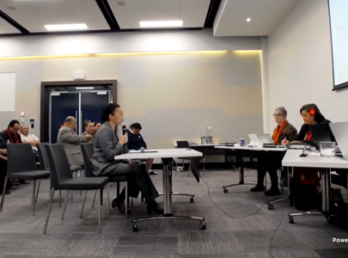Netsafety Week 2022 – Tips and Myths articles
Date
5 Sep 2022
Related Expertise
For #NetsafetyWeek2022, we shared helpful tips and debunked harmful myths to remind everyone how to stay safe online. We have collated a combination of our efforts below for easy reference and communication. We welcome you to utilise our advice below for your own advantage in our increasingly digitalised world.
Helpful Tips
Pre-emptive restriction of unsolicited communication
The internet is a great place to connect with other people in various communities; however, the accessibility of social media can lead to unsolicited communication. To avoid unwanted interactions, platforms like Instagram offer tools to prevent exposure to specific content. Each individual has their own particular triggers and/or sensitivities. Filters can protect you from certain content you may personally find offensive and can assist you in tailoring your online experience. You can find a guide on how to utilise this feature on Instagram to benefit your online welfare here.
Vigilance of social surveillance
Family violence can now occur despite physical distance due to the availability of our online information and the constant contact afforded by online platforms or apps. Abusers now have unprecedented access to others, accompanied by an ability to cause further harm in ways previously unavailable to them following a breakup. This includes but is not limited to incessant messaging on apps such as Messenger, WhatsApp or Snapchat; intimate image distribution; cyberstalking; hacking; hijacking digital health platforms, and sending abusive messages via the reference fields on bank payments.
Whilst victims of these types of violence are not at fault; there are ways we can protect ourselves from this kind of abuse as resolutions to deter and punish offenders awaits further determination, such as:
- sharing passwords and codes with caution;
- changing your passwords regularly;
- using two-factor authentication;
- using ‘blocking’ and ‘restricting’ features on social media; and
- being careful about leaving a phone unlocked whilst not in your hand.
“There are also avenues for redress for removing harmful content and preventing future harm under the HDCA and Family Violence Act 2018. Contact us for more information and assistance.
For more information, our experts Kesia Denhardt and Arran Hunt have discussed this type of family violence in a Stuff article.”
Restricting the reach of a particular communication
While keeping our social media accounts active might be a fun and easy way for everyone to know what’s going on with us, it’s always a good idea to consider the number of people we choose to share such content with, especially when it comes to posts about more personal or private matters.
On Facebook, you can do this by limiting access to your posts and photos to your ‘Friends’. To narrow it down more, you could restrict access to your content by selecting a few of your ‘Friends’ instead of ‘Everyone’. On Instagram, you can utilise the ‘Close Friends’ function, or you could make a separate private account with even fewer followers than your main public account.
Even with restricting the number of people that see your content, it is still worth considering that nothing really is private once it’s online. Unfortunately, things can always be screenshotted and shared without our consent.
Awareness of financial scams
Over the last decade or so, there seems to be a growing number of phishing emails, and they tend to appear more and more genuine as time goes on.
Phishing is when someone sends an email pretending to be a legitimate, trustworthy source such as the Inland Revenue Department, AT Transport, or even specific people we know. Equally, it could be you they are trying to impersonate. These messages trick us into revealing sensitive or confidential information, such as specific bank account details, or answers to security questions to our social media accounts, making it easier for them to hack us.
Signs of a phishing scam include but are not limited to:
- The email being sent from a random email address, often with a bunch of randomised letters and numbers in the username;
- The sender’s details, sign-off, and/or email signature at the end of the email are vague;
- The email greeting you in impersonal and vague terms (e.g. “Dear Sir” or “To Account Holder”);
- The email being about accounts and/or subscriptions which you don’t have or banks that you don’t hold an account with; or
- The email containing spelling and grammatical errors
If you’re still unsure if an email is genuine or not, it’s a good idea to copy and paste a part of that email onto Google and see what the results say. For more information about phishing, check out this Netsafe article.
Wheaton’s Law
Created by actor Will Wheaton, from Star Trek: Next Generation and The Big Bang Theory, it is simple, to the point, and would make the internet a much better place if everyone followed it. It is the greatest, and only, law of etiquette that is just four words long – “Don’t be a dick”
These four words could prevent so much of the online harm that people experience. Before you hit ‘send’ or ‘upload’, apply Wheaton’s law yourself and see if you would be breaking it. If so, consider changing the substance or tone of your communication. Or perhaps it is not worth communicating at all.
Harmful Myths
Sharing isn’t as harmful as posting
We often hear that contributing to the virality of an online post (such as passing on an intimate image or sharing, ‘liking’ or re-posting a post on Facebook) is ‘not as bad’ as authoring the original post. This is not necessarily true. Authorship of a post does not mean the consequences of its virality square exclusively on the originator. Anyone involved in disseminating harmful digital material is potentially guilty of contributing to the effects of its creation, including harm.
Passive online activity has no impact
The myth that anything posted online has no real-world impact is undeniably false but continues to pop up in practice. As our digital footprint grows, our online presence is increasingly susceptible to scrutiny. Employers, institutions, and customers can design their opinions of us based on our online interactions. What we ‘like’, share and re-post can be extensions or expressions of ourselves but sometimes lacking in necessary context.
Hackers only target the wealthy
Hackers do not discriminate. While some hackers aim to steal people’s money, others may be incentivised for more personal reasons. It is important to remember that hackers may also want to hack your personal information out of revenge (including revenge porn) to harass or embarrass you. If anything, hackers will tend to target those who are generally unaware of internet safety, have limited knowledge of technology and can be tricked easily. Sadly, everyone, to some extent, is at risk of being hacked. This highlights the importance of specific internet safety skills, such as knowing how to spot a phishing email.
The best solution is to “turn it off”
Often since the harm is communicated through a screen, the common expectation from others is that the victim can turn off their device to avoid further harm. This is a harmful misconception that misunderstands the nuance of digital reach. A victim of harm isn’t responsible for the harm committed to them, a motivation to defend one’s self is natural, and the effects of these harmful communications go beyond the direct consumption of the victim, circulation of content, and the knowledge of its existence is a painful reality to contend with.
Harmful content is a by-product of a victim’s mistake
The adage “if you don’t want it out there, don’t post it” is both redundant in the age of deep fakes and photoshop and incorrectly misapplies the blame to victims who reserve the right to be free from public humiliation. Content can be manipulated to exaggerate or insert victims into situations they hadn’t originally been in. The sophistication of these technologies increases the propensity and commonality of these attacks. People also reserve the right to a level of privacy; the violation of this right should be levelled at the attacker. The theft of digital property is akin to the theft of tangible property and should be treated as such.
Often, it’s easy to assume that ignoring offensive content will remove the severity of this on the victim’s wellbeing. Unfortunately, the ability to log off is becoming more difficult in a world where our online presence is increasingly intertwined with our “real world” selves. It’s important to acknowledge these realities and the fact that these communications do not exist in a vacuum. Resources like the NetSafe and the Harmful Digital Communications Act (HDCA) exist to assist and create tangible, pragmatic solutions to these issues.
If you are the victim of digital harm, our team can help. You can contact our HDCA expert Arran Hunt here if you are in need of assistance.
Disclaimer
This paper is not intended as legal advice and it should not be considered or relied on by any reader as such. The article should not be treated as professional advice of any kind. It is for educational purposes only. Please note that the material linked in the article is for illustrative purposes only. Its inclusion is intended to make the paper accessible for all readers, not just lawyers. Except for our own web articles, Stace Hammond does not necessarily agree with or endorse the statements made in the linked material. We reference it for its overall usefulness for this discourse. Stace Hammond does not claim any copyright or other intellectual property rights in those linked works. We also reserve the right to correct any errors in the paper that we discover.
Subscribe
Get insights sent direct to your email.










